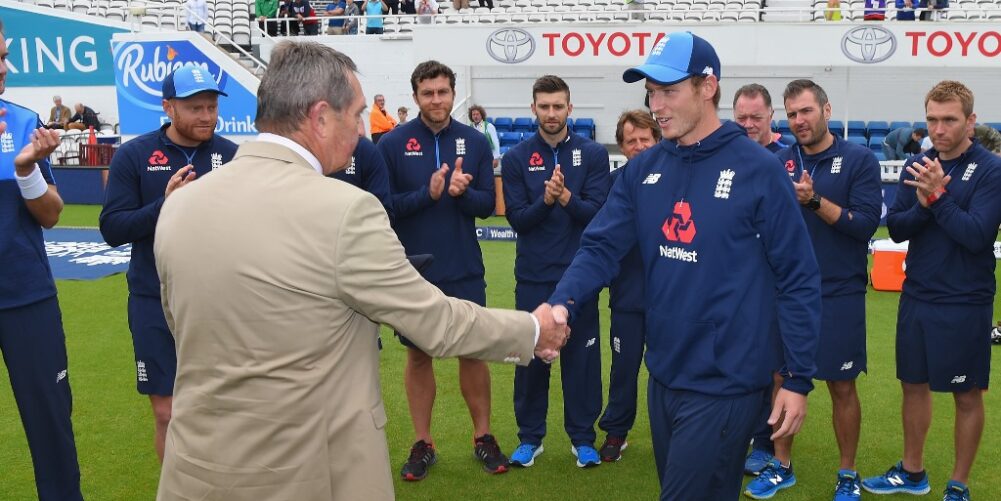Derek Pringle gets technical as he analyses the latest batsman to try out in England’s most problematic position…
Tom Westley is the sixth No.3 England have tried since Jonathan Trott, arguably the most successful incumbent of the recent past, suddenly vacated the post in Australia four years ago. Others to have filled the role are Joe Root, James Vince, Nick Compton, Gary Ballance and Ian Bell. Only Root has made a hundred from that position in the last 31 Tests.
Westley looks to have the skills and temperament to make a success there, despite making only 25 on debut against South Africa. It can be tricky making firm judgments just an innings into a player’s international career but one good sign is that Westley did not look overawed despite appearing nervous during pre-match interviews. Yet his demise, four balls after lunch, suggest he will have to work on his shot-making in the channel outside off-stump, often a problem area for on-side players like him.
At 28, he has been made to wait for his big moment and there is no doubt that having been round the block a few times in county cricket, just like England’s other two debutants here at the Kia Oval, Dawid Malan and Toby Roland-Jones, will have helped him to know his game.
Such maturity does not stop the nerves pinging on a big occasion like this, though you would not have known it watching him and Alastair Cook add 52 for the second wicket.
Any soothing of anxiety tends to come from within. But if outside agencies could put you at ease then receiving your cap from Essex legend Graham Gooch, once Westley’s county coach, and then being welcomed to the crease at the fall of the first wicket by Cook, an Essex team mate of longstanding, is about as reassuring as it can get when Morne Morkel and Vernon Philander are pawing the ground with eager intent.
He would have been encouraged too by Root’s decision to back his batsmen and bat first after winning the toss, despite leaden skies and a green tinge to the pitch. Of course, those two factors would have got Philander and Morkel’s fingers twitching with excitement especially after the former dismissed Keaton Jennings for nought to bring Westley, their first of England’s trio of debutants, to the crease.
He began with a couple of calm leaves outside off-stump before, with his fifth ball, Morkel strayed too straight and fed his forte, the wristy flick off his legs which speeds to the square-leg boundary for four, just as this one did.
This aspect of his game, and the assured aggression he showed against Keshav Maharaj, whom he struck for two fours in the spinner’s opening over, reminds me of John Crawley, who played 37 Tests for England in the Nineties.
Crawley was devastating at putting away through the leg-side any bowling that ventured too close to his stumps. Yet he struggled against bowlers like Glenn McGrath, who ploughed a furrow seven inches outside his off-stump with drip-dripping persistence. Against them he had little answer and it may be that Westley will similarly struggle for solutions given his dismissal, caught at slip driving at one from Chris Morris, was identical to those which undid Crawley on a regular basis.
You can tell Westley has thought about resolving this particular issue. When he arrived at the crease he took an off-stump guard and then held his bat wide of that. I cannot recall too many top-order batsmen in Test cricket starting off that far across their stumps, but it allows him to be very still at the moment the ball is bowled, which should enable him to judge the line and length better and more quickly. Crucially, too, it allows them to leave alone balls in the Test danger channel just outside off-stump.

Being still also enables him to stand upright and clip the ball through the on-side without his head falling over. It is a shot played best with minimal feet movement but one he may look for too often. Certainly the ball from Morris that dismissed him was a good one, swinging away late from a fullish length. But he’d initially shaped to play his favourite leg-side flick before adjusting to drive it straight after he saw the swing. This is all happened in the space of micro-seconds but had he managed a bigger movement of the front leg towards the ball in the first place, he might not have edged it.
Before that, Shane Warne, never overly effusive about young English batsmen unless they come from Hampshire, said he liked Westley’s “intent”, which roughly translates that he used his feet to the spinner. “He didn’t look anxious, either,” said Warne, a master at sniffing out the slightest apprehension in batsmen.
His cricketing pedigree, club cricket for Weston Colville, Essex U19s, Durham University, Essex and England Lions, is as comprehensive as it comes, a cricketing education as broad as it is deep.
Test cricket, though, is the apogee of all that, a place where players stand or fall by their temperament and all the little glitches, quirks, quips and luck that affect it. So far, Warney obviously quite likes what he sees and that can only be a good thing.
Perspective is also important here. As someone pointed out – Westley making 25 is seen as promising whereas if Gary Ballance had made 25 here, he would have been buried beneath the criticism.
It is an interesting point but only fair if Westley had not been making his debut. It takes a few innings to settle at this rarefied level, especially against a fine bowling attack like South Africa’s, and for 49 balls Westley looked like he belonged. By the end of the summer, we’ll know for sure.
*This article originally featured in The Cricket Paper’s 28 July 2017 edition.













